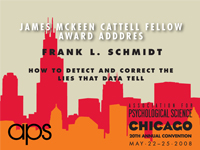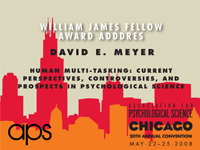Delight, Desire, and Dread
One of the most intriguing things about our brain is the interconnectedness of its various structures and functions. We used to think that one discrete area of the brain was responsible for each particular behavior, but we now know this isn’t the case. By the same token, individual behaviors we used to think of as being singular phenomena are now broken down into distinct components both behaviorally and neurologically. One example, presented by APS Fellow and Charter Member Kent Berridge of the University of Michigan, in a talk sponsored by the National Institute on Drug Abuse, involves the fascinating separation of the notion of pleasure into liking and wanting and its implications for motivation and addiction.
We tend to think that if something gives us pleasure, then we naturally like it. But is liking the same thing as wanting? One way to answer this question is to look at the brain’s dopamine system, well-known for its involvement in reward. When something becomes desirable in the sense that you want it, we’re talking about “incentive salience,” which makes the stimulus attractive. In a variety of experiments, Berridge and his colleagues activated the dopamine-rich mesocortical limbic system in mice or rats, and it triggered wanting. Though the animals wanted the stimuli to which they’d been conditioned, how do we know the mice necessarily liked it?
Berridge and his lab devised a series of clever experiments to tease apart these two phenomena. They used the behavioral marker of liking: both babies and rats stick out their tongues when they like something. So one way to distinguish between the different forms of desire is to create a mutant mouse, as Berridge’s colleagues did, with extra dopamine in its brain. The excess neurotransmitter caused the mouse to want sweet rewards more, but it actually didn’t like the food more. The scientists were able to deduce this based on the rate of tongue protrusions, the tell-tale signal of liking. Control mice and mutant mice showed relatively the same number of protrusions, despite the fact that dopamine had been ramped up in the latter strain, which definitely showed greater wanting of the food. What this means is that the mesolimbic dopamine system activates wanting without liking, the same process we see in drug addicts. In addition to this activation, the system becomes sensitized so that over time, the mesolimbic system becomes hyper-reactive and addicts will want drugs more and more even though they are getting less and less of the liked pleasure. Add to this the fact that sensitization lingers years after drug use stops, and it becomes a little clearer just how difficult it is to treat addiction.
On the other side of the coin, in counterintuitive contrast to this breaking apart of motivation into distinct components, there appears to be a common source for the opposite emotions of desire and fear. In the lab, the same region of the brain, the nucleus accumbens (NA), seemed to be activated by both desirable and fearful stimuli, which is a bit confounding. One explanation for this phenomenon is that one site in the brain is generating both emotions. In a series of experiments, Berridge and his lab created three different environments to test this hypothesis. One was the rat’s comfortable home, the second was the lab, and the third was the lab with the music of Iggy Pop playing the background. (You should be able to deduce at this point that the third environment was meant to be extremely irritating — when given a choice, rats will turn off Iggy Pop’s music rather than leave it on.) These variable conditions result in fluctuations in the rat’s NA: being in its home generated desire, and listening to Iggy Pop generated dread. Their hypothesis was confirmed: The same site in the brain can be activated to generate either desire or fear. Further, the scientists found that mesolimbic dopamine was crucial to generating both. Now research is needed on the shared psychological process, as yet unnamed, that can be flipped into either desire or dread.
The work of Berridge and colleagues elegantly showcases how seemingly conflicting psychological components drive our motivations. What seems to be one behavior can actually be divided, and conversely, some things that seem completely opposite may share the same brain structure. This research tantalizingly leads to the question of how we can be aware of the emotions and motivations that combine these psychological components, but not have direct access to the underlying components themselves.




APS regularly opens certain online articles for discussion on our website. Effective February 2021, you must be a logged-in APS member to post comments. By posting a comment, you agree to our Community Guidelines and the display of your profile information, including your name and affiliation. Any opinions, findings, conclusions, or recommendations present in article comments are those of the writers and do not necessarily reflect the views of APS or the article’s author. For more information, please see our Community Guidelines.
Please login with your APS account to comment.